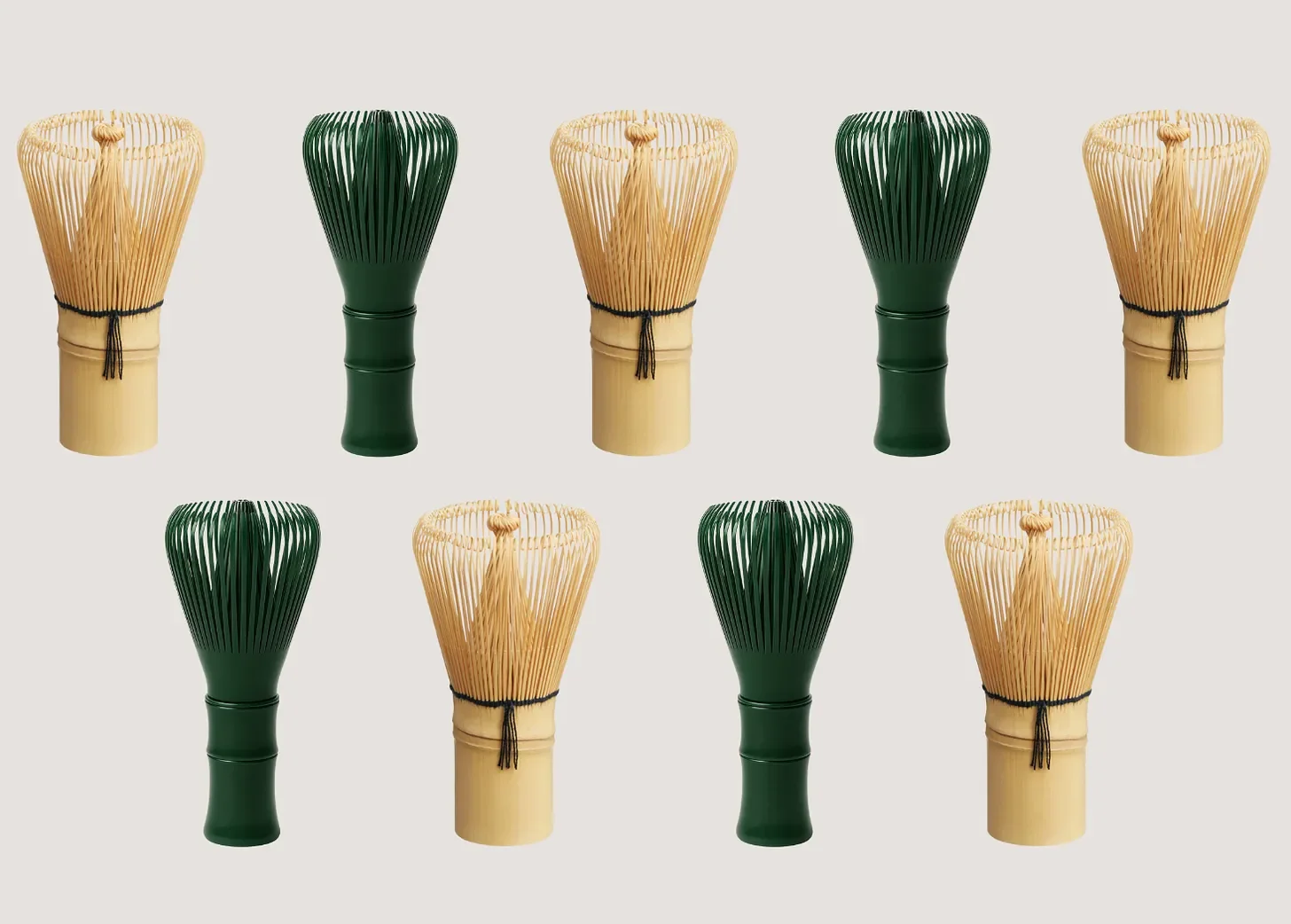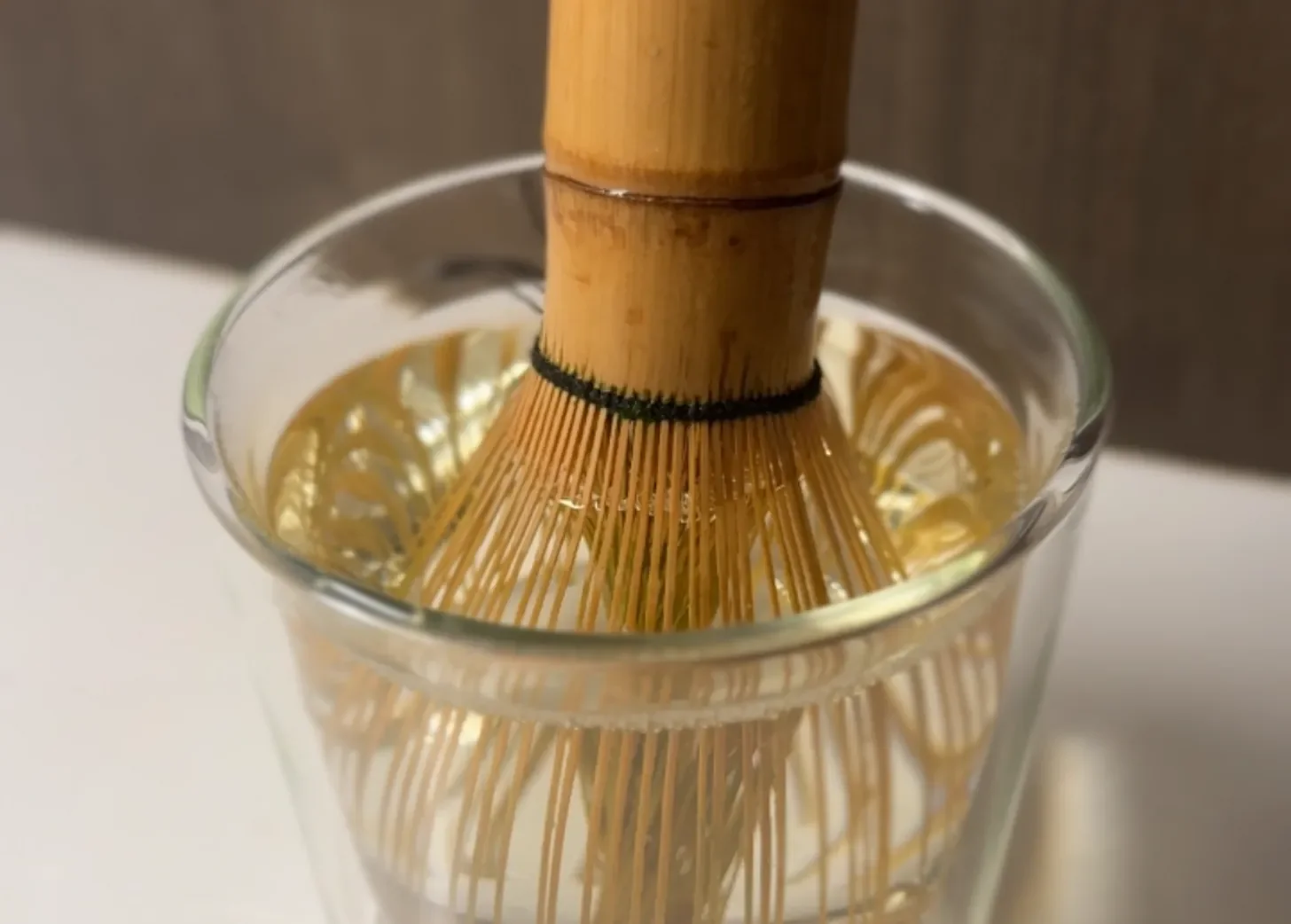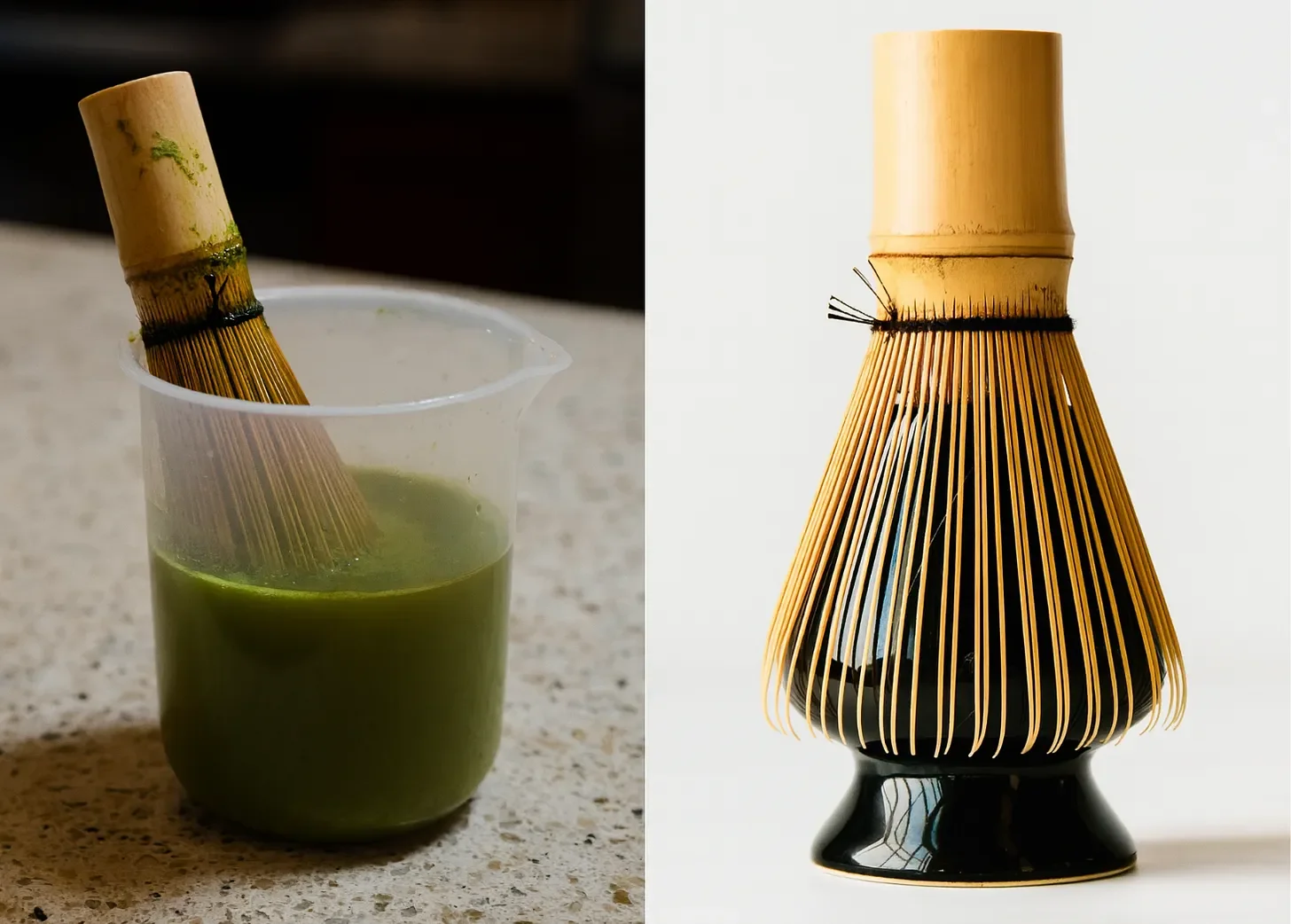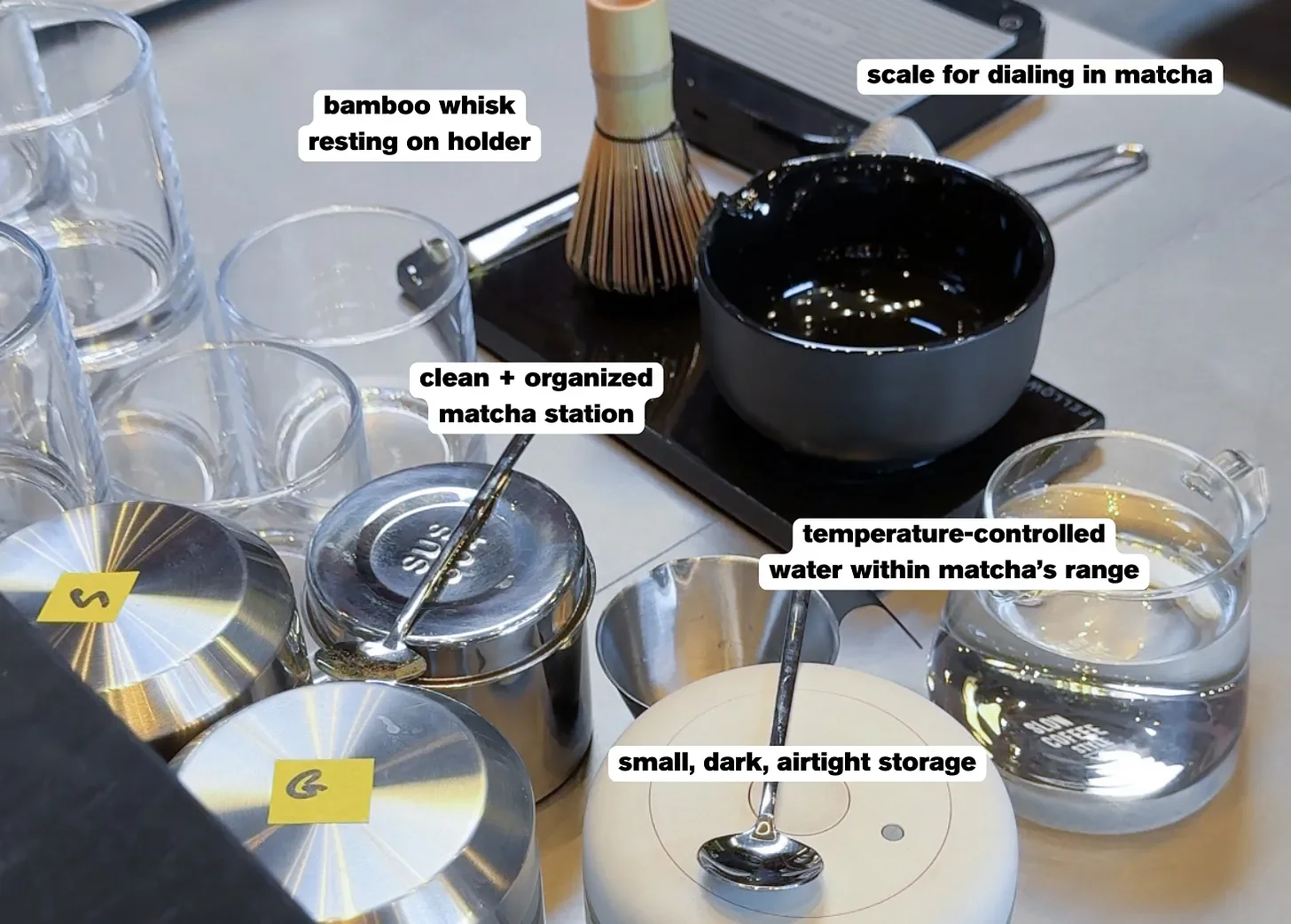Hand-Whisking Myths, Misconceptions, and Best Practices for Cafes and Popups
What every operator should know before choosing this preparation method
TL;DR for Busy Operators
Hand-whisking is often romanticized as the “authentic” or “superior” way to prepare matcha. In reality, context and operations matter more than aesthetics. Hand-whisking can absolutely elevate your program when done intentionally, but it also comes with trade-offs around workflow, sanitation, and scalability.
Key takeaways:
Hand-whisking does not automatically mean better flavor or higher quality.
Bamboo whisks require diligent maintenance and frequent replacement in foodservice.
Consider customer experience, speed, and sanitation before making hand-whisking central to your program.
The “right” method is the one that aligns with your operations and brand story.
Material Differences: Bamboo vs. Silicone Resin Whisks
Understanding your tools is key to scaling responsibly.
Bamboo Whisks (Chasen):
✅ Pros: Aesthetic appeal, rooted in tradition, creates natural aeration and microfoam ideal for hot drinks.
⚠️ Cons: Fragile, prone to tine breakage, not foodservice-safe for high volume, cannot be sanitized or placed in dishwashers. Bamboo absorbs moisture, making it prone to mold and bacterial growth if soaked or improperly dried.
Silicone Resin Whisks:
✅ Pros: Durable, dishwasher-safe, consistent whisking, ideal for iced drinks and high-volume environments.
⚠️ Cons: Less romantic and “traditional,” may not create identical microfoam texture as bamboo.
For cafes, resin whisks often offer a practical balance between craftsmanship and efficiency while maintaining quality and food safety standards.
Food Safety: What Cafes Should Know About Silicone & Resin Whisks
Material verification matters: Only use food-grade, heat-resistant silicone or resin explicitly certified for food contact (FDA or LFGB). Avoid generic “resin” tools with unclear material composition.
Microplastics: High-quality, food-grade silicone is generally considered chemically stable and resistant to breaking down under normal use. While it is less likely than lower-grade plastics to release microplastic particles, any utensil showing signs of wear, cracking, or stickiness should be replaced to ensure continued safety and performance.
Temperature tolerance: Confirm the whisk’s safe range (ideally up to 400°F / 200°C) to ensure stability during hot beverage prep and dishwasher cycles.
Sanitation: Ensure it’s dishwasher-safe and can withstand commercial cleaning protocols without degrading.
Usage fit: For high-volume cafes, resin/silicone whisks offer durability and hygiene benefits—bamboo is better reserved for ceremonial or small-batch prep due to its fragility and risk of mold growth.
Common Myths and Misconceptions
Myth 1: Hand-whisking means matcha will taste better or be fresher.
Preparation alone isn’t an indicator of quality—the entire matcha program is.
A cafe could hand-whisk every drink but still serve oxidized, poorly stored matcha from large transparent containers (a common issue in foodservice).
Technique can’t compensate for compromised ingredients, improper storage, or using water that’s too hot and beyond matcha’s ideal range (160–175°F).
Freshness comes from systems, not the whisk itself.
While whisking to order conveys a sense of freshness through perception, actual freshness depends on your systems. Unless you are milling matcha fresh to order, the average cafe is serving pre-ground matcha that has already begun oxidizing—the moment tencha is ground into powder, oxidation begins.
The goal for cafes is to slow this process through airtight storage, light protection, refrigeration (if appropriate), and controlled batching protocols.
Myth 2: Hand-whisking is always better than batching.
Yes and no. Context is everything.
If you have a “slow bar” setup where customers can observe and learn, hand-whisking enhances storytelling and experience. However, in high-volume environments where speed and consistency are critical (like popups or busy cafes), batching often serves both your team and your customers better.
Both methods can coexist successfully—hand-whisk for education or presentation, batch for scalability and peak hours or establish a hybrid model.
Myth 3: Hand-whisking “honors” matcha culture or tradition.
Many cafes feel pressured to hand-whisk to appear more respectful or “authentic.” But traditional Japanese tea ceremony and modern cafe operations exist in completely different contexts. A busy cafe isn’t meant to replicate the quiet, meditative environment of a tearoom—nor should customers expect that experience from baristas.
Using traditional tools like the chasen (bamboo whisk) or chawan (bowl) doesn’t automatically convey cultural respect if technique, handling, or storage are poorly executed.
The most authentic way to honor matcha in a cafe is through education, consistency, and respect for the ingredient—not through performative gestures or aesthetics alone.
Technique: Using a Bamboo Whisk in a Cafe
Example of Jules’ personal Japanese-crafted bamboo whisk. Even with proper care and maintenance, bamboo naturally wears over time—the tines will eventually fracture or break. Inspect the whisk daily and throughout service to ensure it remains in good condition.
One of the most common mistakes seen behind the bar is applying too much downward pressure while whisking—similar to how one might tamp espresso. Baristas often press the whisk against the base of the bowl to “blend” the matcha more aggressively, but this causes the delicate tines to scrape against the surface, leading to fractures, splintering, and premature breakage.
Instead, train staff to whisk lightly from the wrist, keeping the tines suspended just above the base of the bowl. The motion should be quick and rhythmic, forming a “W” or “M” pattern to evenly aerate and suspend the matcha without grinding the tips against the bottom.
Think of the whisk as a tool for aeration, not agitation—the goal is to create microfoam and uniform suspension, not to mash or pulverize the powder. Proper technique not only extends the lifespan of your bamboo whisks but also produces a smoother, more balanced cup.
How to Care for a Bamboo Whisk
Left (recommended): Bamboo whisk briefly soaking with hot water halfway up from the ends of the tines. Right (not recommended): The water line is too high and close to the threading of the bamboo whisk.
Most cafes use mass-produced Chinese-made whisks, which are generally lower in quality than handcrafted Japanese-made chasen. As a result, they tend to wear out much faster, especially in high-volume environments where frequent use, heat, and moisture accelerate degradation. Regular inspection and proper care are essential to maintain performance and hygiene.
Pre-Service
It’s not necessary to soak your bamboo whisk in water that reaches the threading of the tines. In fact, prolonged or excessive soaking can weaken the tines over time and shorten the whisk’s lifespan.
Briefly soak in hot water to soften the tines (no longer than 30 seconds). Bamboo is naturally porous, so over-soaking can weaken fibers and shorten the whisk’s lifespan.
Keep the waterline below the thread binding to prevent loosening or splitting, about halfway up from the ends of the tines.
Inspect for any fractures, splintering, or mold before use.
During Service
Left: A bamboo whisk soaking in murky matcha water. This practice is unsanitary since bamboo is prone to mold, and prolonged soaking weakens the tines as they absorb water. Right: A bamboo whisk properly stored on a whisk holder, allowing it to dry while maintaining its shape.
Rinse the whisk thoroughly during idle periods to prevent buildup. Some cafes prefer to rinse after each drink, similar to how bar tools are cleaned between cocktails.
How to rinse: Keep a small bowl or pitcher of hot water nearby for quick rinsing and replace it as it becomes cloudy. Gently tap or shake off excess water and place back on a whisk holder.
Avoid soaking the bamboo whisk when not in use. Place the whisk on a holder to dry and maintain shape.
Bamboo is highly porous, meaning it can absorb dairy, sugars, and other residues, leading to bacterial growth and cross-contamination. Reserve bamboo whisks for preparing pure matcha and water only.
Inspect the whisk daily and throughout service. Replace it immediately if the tines begin to fray or break—loose fragments can end up in drinks, creating a food safety risk and potential liability for your business.
Post-Service
Rinse the tines with hot water only (no soap or detergent). Add hot water to a matcha bowl and whisk to clean.
Wipe the handle clean with a damp cloth.
Never run a bamboo whisk through a commercial dishwasher.
Use a soft brush (such as a mini bamboo brush) to gently remove residue.
Dry on a whisk holder for proper ventilation and to preserve shape.
Never store a moist in an airtight container, trapped moisture promotes mold.
While high-quality bamboo whisks can last for months (or even years) with proper care, their lifespan shortens significantly in high-volume cafe environments. Frequent use, moisture, and improper use, so even with consistent maintenance, regular replacement is essential to maintain quality and food safety.
Training Your Team
Newly opened Hedge Coffee in San Francisco showed all the hallmarks of a well-designed and intentional matcha station with proper systems in place.
If hand-whisking is central to your brand, train your team to scale the ritual efficiently and consistently.
Create SOPs (Standard Operating Procedures) that outline whisk care, cleaning, inspection, and replacement intervals. Emphasize the connection between a clean, intentional whisking station and perceived quality.
Also ensure your matcha station mirrors the same level of care—organized, uncluttered, and intentional.
(See: Matcha Station Red Flags)
For Popups and High-Volume Cafes
Efficiency is everything. Hand-whisking in a popup model can bottleneck service, reduce output, and increase fatigue.
Consider hybrid models:
Hand-whisk for hot matcha or slow-bar presentations.
Batch for iced drinks and during peak rushes.
This balance allows you to maintain storytelling where it matters while keeping service efficient and profitable.
(See: Batched Matcha Myths and Best Practices)
Additional Equipment for Hand-Whisking
Electric bamboo whisk handles: Reduce wrist strain and help maintain consistency in high-volume preparation. Great for staff with mobility needs.
Resin whisk adapters: Some resin whisk systems allow detachable heads that can be sanitized separately—bridging tradition with practicality.
Whisk holders (chasen naoshi): Maintain shape and allow airflow post-service (a must for bamboo whisks).
Next Steps for Operators
✅ Evaluate your workflow. Where does hand-whisking fit operationally? Does it enhance or hinder efficiency?
✅ Audit your tools. Are your materials foodservice-safe and easy to maintain?
✅ Train your staff. Ensure they know proper whisk care, storage, and replacement intervals.
✅ Educate your customers. Use signage or menu notes to explain your preparation method—transparency builds trust and appreciation.
We Want to Hear From You
Have a question or experience to share about hand-whisking? Drop it in the comments below—your feedback helps us shape future guides and resources for cafe operators.
We’re also launching our first YouTube Q&A, where we’ll dive deeper into your questions. Subscribe to The Matcha Program on YouTube, and if you’d like to be featured in a future episode, leave your question in the comments.
If you haven’t already, follow us on Instagram and TikTok for more behind-the-scenes content and matcha education for cafés and pop-ups.








